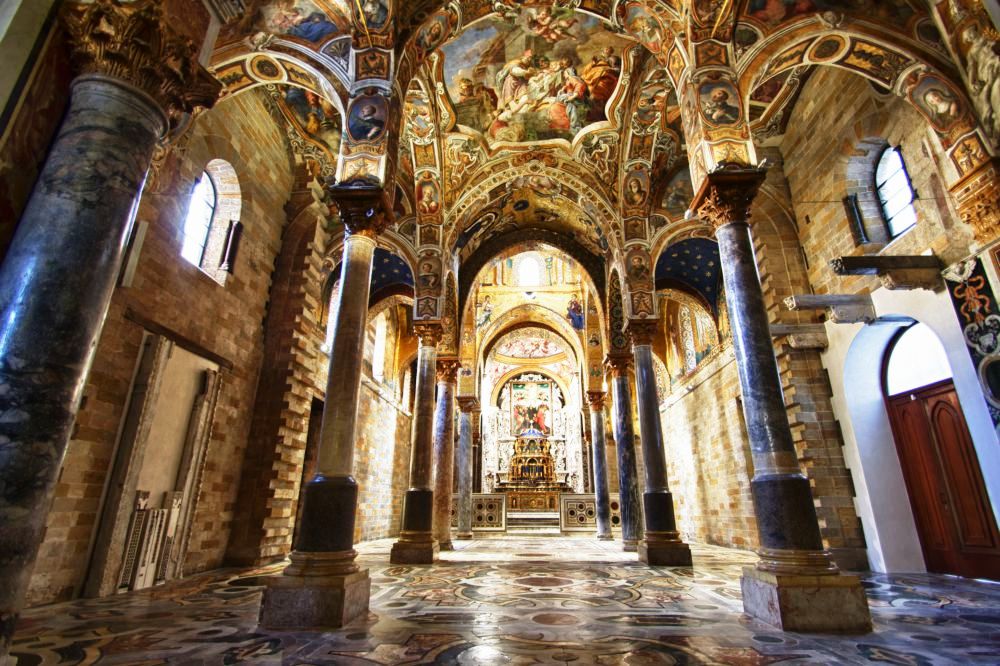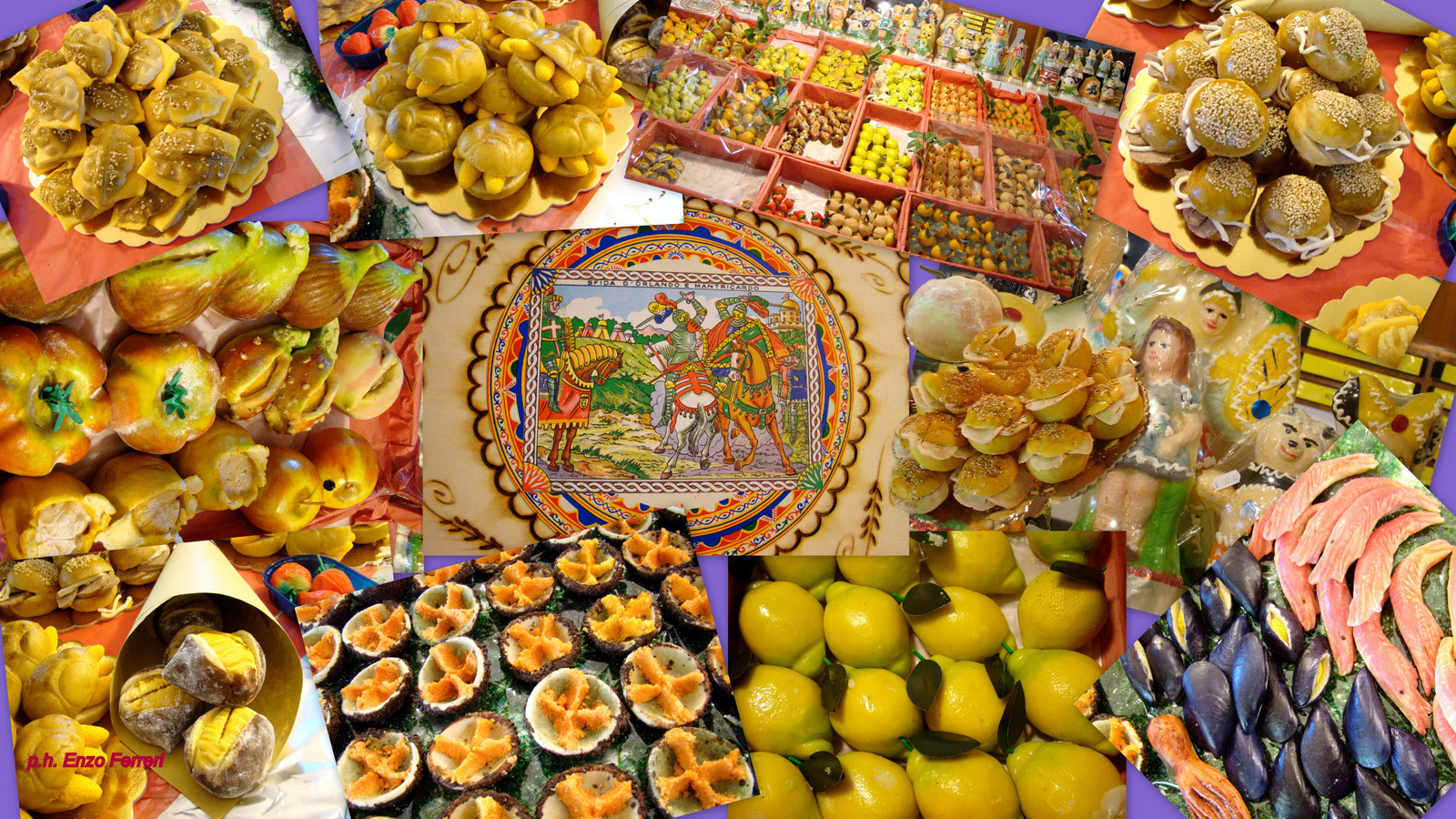
Read Italiano version
The Church of Saint Mary of the Admiral, or “La Martorana”, along with the small church of San Cataldo, dominates Bellini Square. Built in 1145 by George of Antioch, Roger II’s admiral or vizier, the church takes its present name from the adjacent monastery founded in 1193 by Eloisa Martorana.
In the Aragonese period it was ceded (1438) to the Benedectine Nuns of the Monastery by King Alfonso “the Magnanimous”. The nuns were famous for the preparation of marzipan fruit, called “frutta di martorana”, which is a feast for the eyes even today especially in the context of the Sicilian “Feast of the Dead” (Festa dei Morti) on November 2nd, when the colorful and delicious sweets are prepared.

The church has been restored and restructured several times over the centuries.
The Martorana was originally composed of a square body which was a Greek cross layout with four columns, holding up the dome on a drum with corner niches, and three apses; and it was also preceded by a porch that connected it to the bell tower. This tower, originally detached from the building, is open with ogival arches below and with columns decorated with the rows of large mullioned windows inlaid with lava and ashlars on the arches. Probabily the first two rows belong to the initial phase of the construction while the two superior rows, decorated with columns placed on the rounded edges, can be dated to the fourteenth century.
At the end of the sixteenth century, the original façade was demolished, the church was extended and the front porch, which united the church to the bell tower, was built. In the second half of the seventeenth century the main apse was removed and there was later raised the presbytery decorated with variegated “mischi” marbles and frescoes was constructed.
The beautiful tabernacle in lapis lazuli is noteworthy. The altarpiece, painted by Vincenzo da Pavia, depicts the ascension and the dome frescoes are by Antonio Grano.
In 1750 a Baroque façade of spectacular effect, designed by Nicolò Palma, overlooked the northern side of the church facing Piazza Bellini, this square was lowered in the nineteenth century.
Finally in 1870 Giuseppe Patricolo removed part of baroque decorations with the intent to bring the church back to its original state.
The Martorana preserves the medieva inlaid marble polychrome floor.
Since 1937 the church has belonged to the Eparchy of Piana degli Albanesi whose liturgy is still in Greek – Byzantine rite.
On entering you can see a “sottocoro” with the vault frescoed by Olivio Sozzi while above you can admire a beautiful gilded wrought iron grill bordering the nuns’s choir whose vault was painted by Guglielmo Borremans. Upon entering the church, among the magnificent Byzantine gold grounded mosaics that cover the interior, the mosaic icon depicting Giorgio D’Antiochia prostrate in front of the Virgin is located in the east apse.
Here the Virgin Mary holds a scroll on which is written a prayer of intercession in Greek that is addressed to Christ by th Virgin herself in favour of the Admiral who had dedicated the church to Her:
“He who built this house from the very foundations, George, the first among all princes, o Son, protect him and his people from every harm and give him forgiveness for his sins, because You have power as the only God, O Word. “
On the opposite side there is the mosaic of King Roger II, dressed like a Byzantine emperor. He is shown here in this glorified position to empasize that in 1098 Pope Urban II granted to Count Roger I and his successors – like Roger II – a decree by which the rulers of Sicily would have exclusive jurisdiction in ecclesiastical matters.
Depicted on a throne at the top of the dome is Christ Pantocrator with his right hand raised in blessing and the Gospel in his left one.
In the frame below it is written:
“I am the light of the world, he who follows me will not walk in darkness, but shall have the light of life (John 8.12).”
The four archangels are represented on the lower level.
At the base of the dome a wooden frieze bears an inscription in Kufic script, painted in white on a blue background, whose text – an exceptional example of coexistence and dialogue between different cultures – includes a hymn from the Byzantine liturgy in Arabic, the mother tongue of George of Antioch.
On the eight sides of the drum eight prophets are shown and the four evangelists are in the corner niches.
To the right of the entrance, on a column – in a couplet – an Islamic inscription reads: “In the name of God, gracious and merciful ….”. This formula is called “basmala” and is located at the beginning of all the Suras of the Koran, except the ninth one.
Inside the church other scenes of admirable mosaics are: the Annunciation on the eastern Arch, the Presentation of Jesus in the Temple on the western Arch, the Nativity of Christ and the Dormition of the Virgin on the vault of the western arm of the cross.
Santa Maria dell’Ammiraglio is one of the most important and famous monuments of the city, a sacred place of considerable charm.
VISITS: CLICK HERE
Circuito del sacro: PURCHASE THE FIRST TICKET AND THE OTHERS WILL ALL DISCOUNTED.
